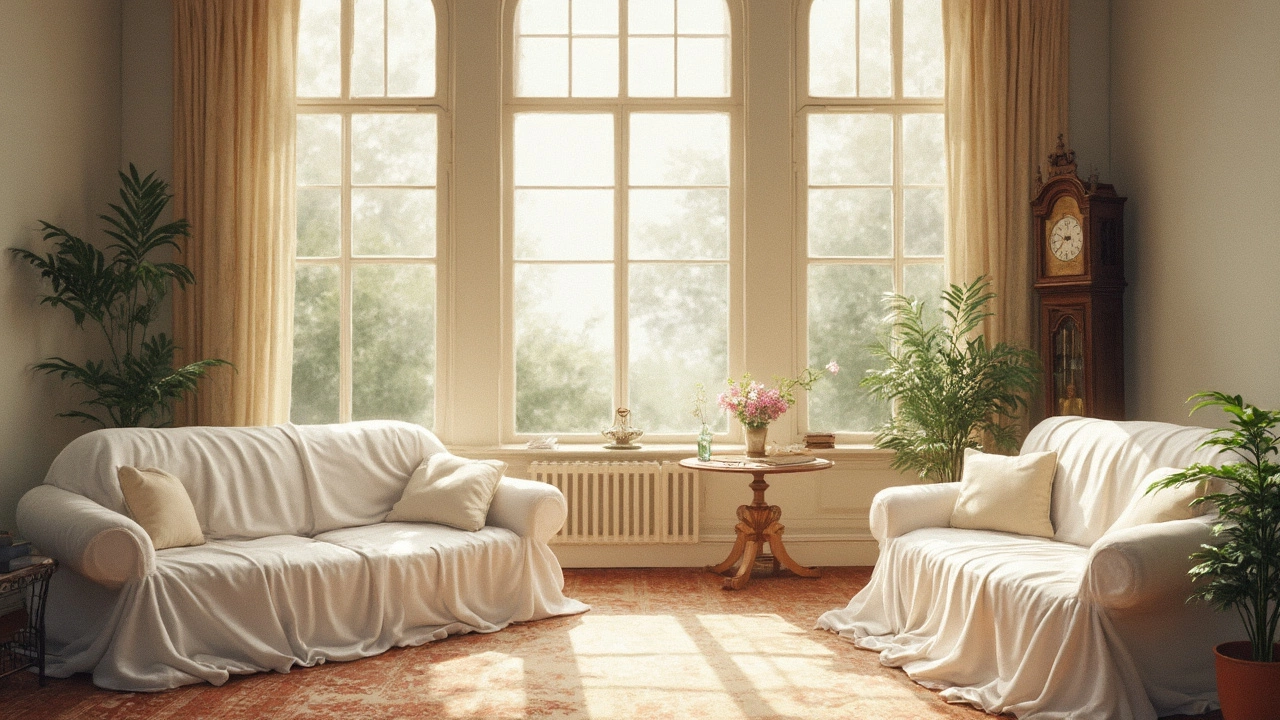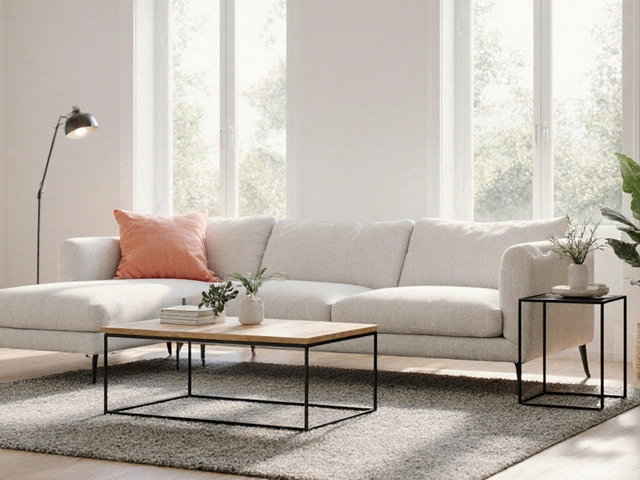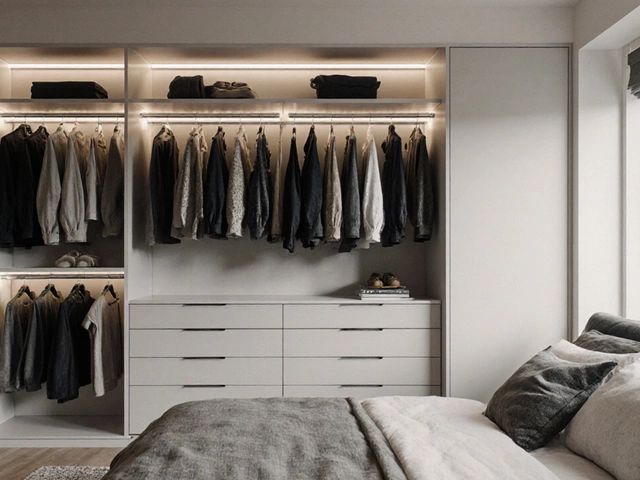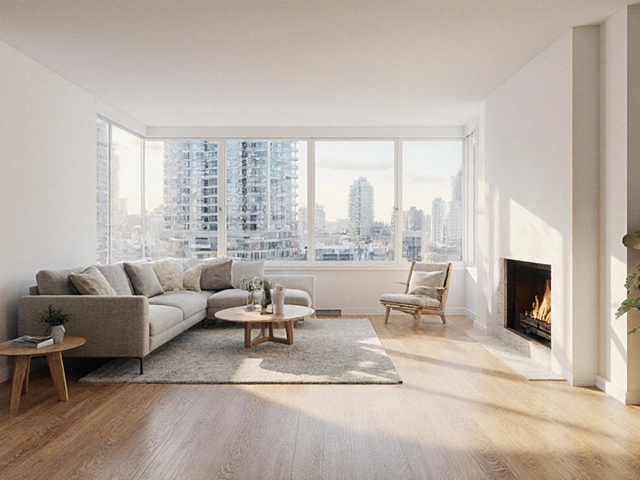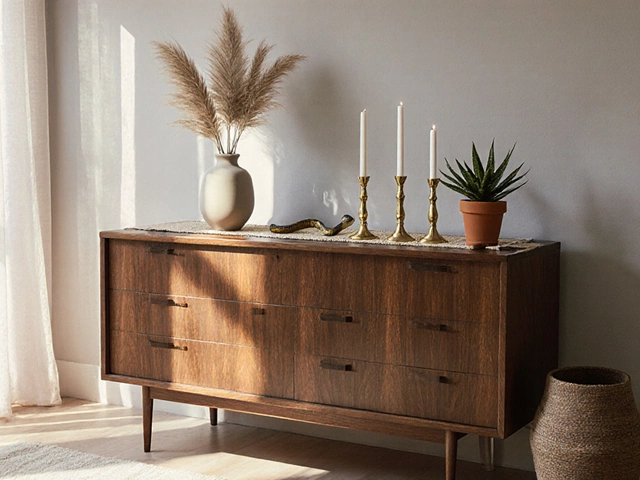Ever walk into a room covered with white sheets and get that spooky movie vibe? Turns out, there's a super practical reason behind it that's all about keeping your furniture in top shape. People have been covering their furniture for ages, and it's not just about aesthetics or keeping things tidy; it's about defense.
Now, you might think, 'Aren't my couches fine without covers?' Well, maybe. But those annoying dust particles and sunlight can really mess with the fabric and finish if left exposed. It's like giving your furniture a vacation from all the wear and tear.
Think of it this way: dust is relentless and sneaky. It settles quietly, creating a dingy look over time and could even make cleaning tougher. By using sheets, you're simply cutting dust off at the pass, stopping it from becoming a bigger headache down the road. Plus, if you care about the longevity of your precious couches or grandma's vintage armchair, this simple sheet trick can save you a lot of elbow grease and money. So, let's dive into these not-so-ghostly benefits!
- The Historical Roots of Covering Furniture
- Protecting Against Dust and Grime
- Shielding from Sunlight and Fading
- Deterring Pests and Preserving Upholstery
- Practical Tips for Using Sheets Effectively
The Historical Roots of Covering Furniture
Believe it or not, the practice of covering furniture with white sheets has been around for ages. Way back in the 18th and 19th centuries, it wasn't just a quirky old habit but actually a clever method for protecting valuables.
For instance, during summer months, wealthy families in Europe—and later in America—would move to their summer houses. To keep their primary homes in tip-top shape while they were away, they’d cover everything, from the couches to the ornate carved tables, with sheets. This kept dust and dirt at bay when no one was around to clean regularly.
Fast forward to Hollywood's golden age, and you'll see this trend popping up in the glamorous homes of movie stars. With the hefty investment sunk into lavish furniture, they couldn't risk sun damage or dust buildup when jetting off on long shoots.
Sure, we no longer have to worry about horse-drawn dirt but the concept holds up. We still cover things today for similar reasons: to preserve and protect. Just imagine, back then, folks were already onto a life hack that's still relevant now!
So next time you toss a sheet over your couch before heading on vacation, just think—you're part of a long legacy of practical, savvy folks who knew that best care sometimes means just covering up.
Protecting Against Dust and Grime
Ah, dust—the uninvited guest in every household. It sneaks in when you're not looking and settles comfortably all over your stuff. When it piles up, dust can make your comfy home feel grimy and dull. Now, imagine your beloved sofa buried under all that muck. That's a major no-go, and it's why tossing a white sheet over your furniture is actually genius for keeping dust at bay.
Dust isn't just unsightly. It can be a real nuisance for your health, especially for folks who have allergies. Plus, dust carries pollutants, pollen, and even tiny critters like dust mites. Covering your furniture helps you add a layer of defense, cutting down the amount of dust landing on your sweet couch or cozy armchair.
How Dust Affects Furniture
Dust can lead to more than just sniffles. Over time, it embeds in fabric and can cause abrasion, wearing down your furniture's upholstery. Plus, grime can stiffen the fabric or discolor lighter textiles. Now, who wants a grayed-out couch when you could have a pristine one?
Practical Tips to Fight Dust
- Choose the right furniture protection: Pick sheets that are breathable but tightly woven to limit dust penetration.
- Regularly shake out the sheets: Take them outside and give them a solid shake weekly. This keeps trapped dust from transferring to your furniture.
- Wash sheets often: Ensure you're keeping things fresh by washing the sheets monthly or as needed, especially during heavy pollen seasons.
By using white sheets as protective covers, you're doing more than just keeping furniture clean; you're keeping it healthier. So next time you think about ditching the sheet rule, think of it as a small step for a big difference in maintaining everything dust-free and long-lasting.
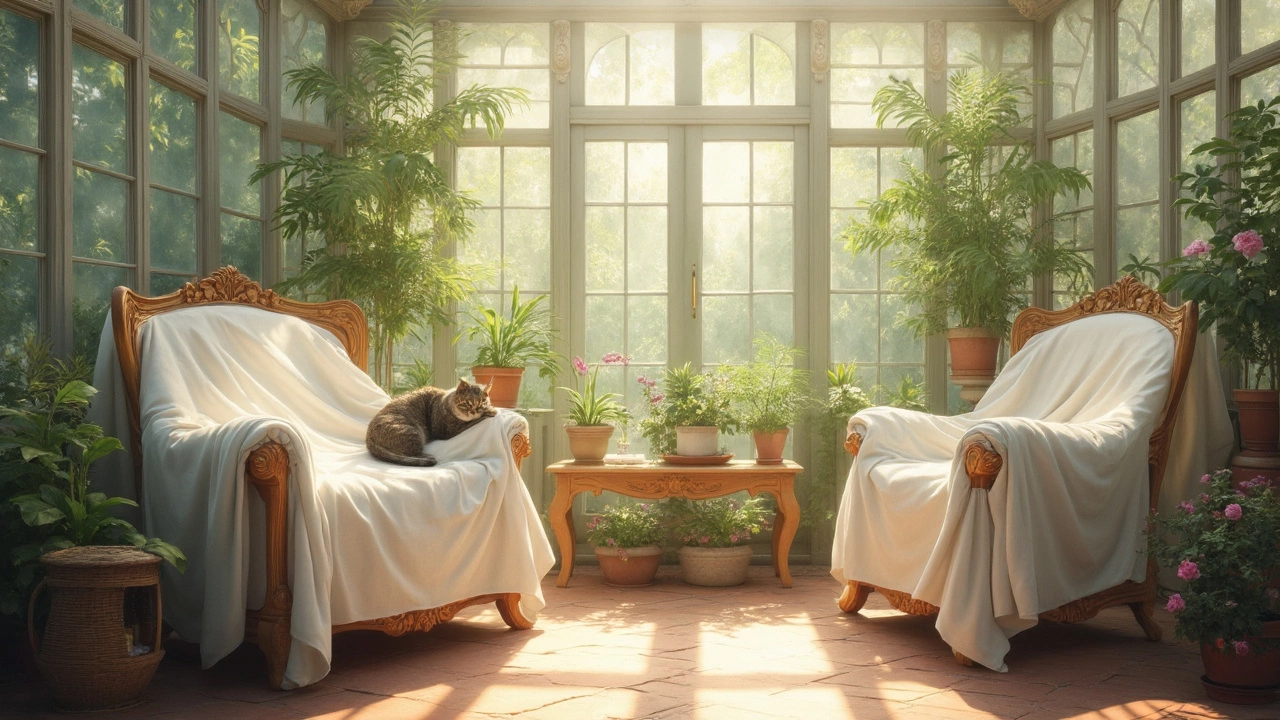
Shielding from Sunlight and Fading
When it comes to our lovely furniture, the sun is like that distant cousin who brings too much drama. Yeah, it's great for natural light, but too much of it can really harm your furniture's fabrics and wood finishes. The sunlight not only fades colors but can also weaken the fibers over time, making them prone to wear and tear.
Understanding Sunlight's Impact
Direct exposure to sunlight can cause furniture to fade dramatically. This is especially true for materials like leather, silk, and certain untreated woods. The ultraviolet (UV) rays are the main culprits, and just like with our skin, they can degrade materials pretty quickly.
For instance, have you ever noticed how the side of your couch near the window looks a shade lighter than the rest? That’s the sun at work. Using white sheets is a simple and cost-effective way to counteract these effects. They act like sunscreen for your beloved sofa, reflecting and diffusing sunlight away from the fabric.
Additional Steps to Protect Furniture
- Use Blinds or Curtains: During peak sun hours, close the curtains or blinds to limit exposure.
- Rotate Furniture: Turn the furniture occasionally so that one side isn't always exposed.
- Place UV Film: Applying UV-protective film to windows can cut down on harmful rays.
Of course, choosing a furniture placement that minimizes direct sunlight can also help a lot in preventing fading. But when rearranging rooms isn't an option, grabbing some durable white sheets will do the trick. It’s a small step that brings peace of mind—knowing that the finishes and colors you loved at first sight are here to stay longer.
Deterring Pests and Preserving Upholstery
Okay, let’s talk pests. These little invaders can be a real nightmare for furniture protection. Nobody wants their beloved couch or cherished chairs to become a feast for moths or a sneaky nest for mice. That's where the clever use of those good old white sheets comes in handy.
Why Sheets Make a Difference
Covering your furniture acts like a first line of defense. It’s not foolproof, but it certainly makes it less convenient for pests to set up shop. Dust mites, tiny critters that can cause allergies, love fabric. A sheet can reduce their hangout spots considerably.In more humid climates, certain bugs find it easier to thrive. A dry, clean sheet acts as an extra barrier. That barrier can deter pests from chewing or nesting as easily, because hey, wouldn’t you choose an open cupboard or a fluffy carpet over an inaccessible, covered sofa with a meticulously tucked sheet?
Preserving the Fabric’s Beauty
Then there's the upholstery itself. We're not just talking about keeping things bug-free; we also want our furniture looking fresh and fabulous. Sunlight and exposure to air can cause fabric to fade faster, making it appear old before its time. A simple sheet can help block out those harmful rays.
Some Extra Tips
- Make sure the sheets are clean and dry when you cover your furniture.
- Consider washing and rotating sheets every few months for hygiene.
- Place mothballs in the room, not directly on furniture, to add an extra layer of pest deterrent.
By keeping your furniture covered with white sheets, you're not only adding a layer of protection against pests but also preserving the upholstery for the long run. It's a little effort that can lead to big rewards for your home aesthetics and wallet.
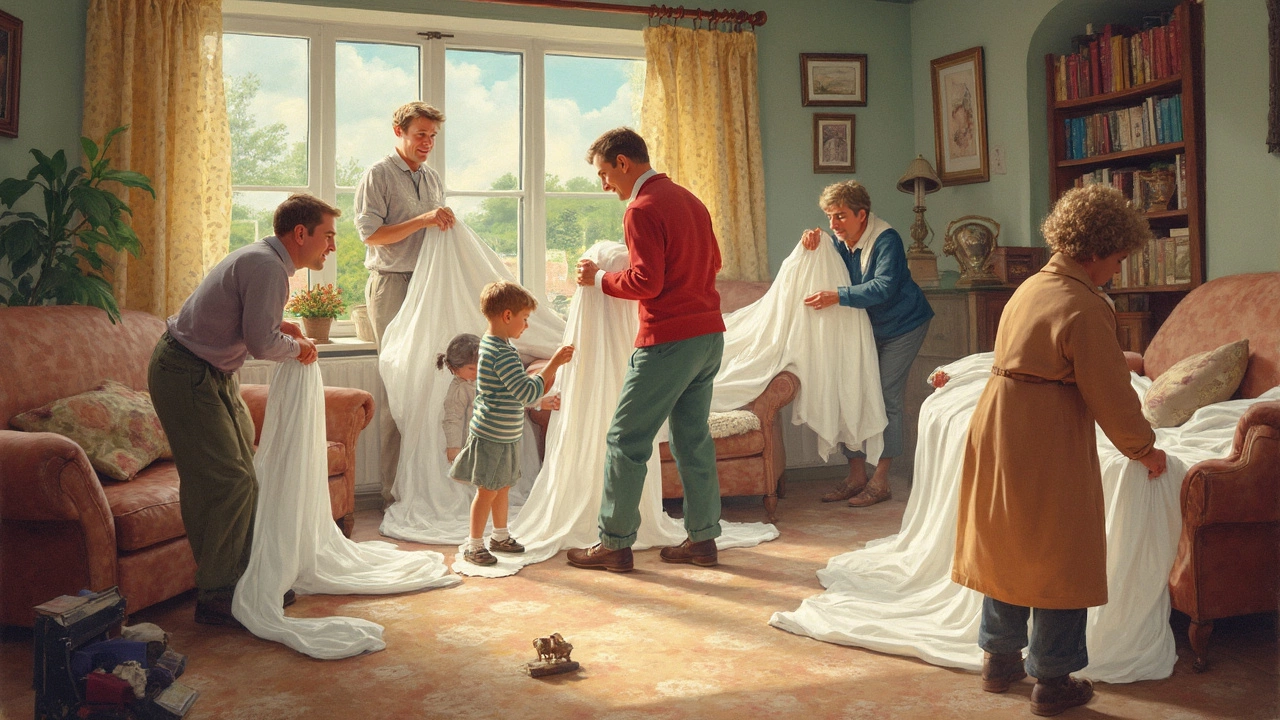
Practical Tips for Using Sheets Effectively
So you've decided to cover your furniture, but how do you do it right? Here's the lowdown on using white sheets for maximum benefit. It's not just about tossing a sheet over and calling it a day; there's a method to the madness.
Choose the Right Material
First off, the type of sheet matters. You're looking for a breathable fabric to avoid trapping moisture, which means cotton sheets are usually your best bet. They're light, easy to wash, and protective without suffocating the furniture.
Secure the Sheets Properly
Nobody wants their nice covers slipping all over the place. Use weights like books or small, fabric-friendly clips to keep things in place. A snug fit helps keep dust and pests at bay more effectively.
Keep It Clean
Make it a habit to toss those sheets in the wash every month. Even though they're protecting your furniture, they need cleaning too. This not only prolongs the sheet's life but also keeps everything looking fresh.
Mind the Sunlight
If you’ve got furniture near windows, consider double-layering with an extra sheet or lining the windows with UV-blocking film. This not only boosts protection for your furniture but also prevents the furniture itself from fading, which is a common problem.
Trim the Edges
If your sheets are too big, trim them to the right size. This prevents dragging and makes everything look neater. Plus, it stops any accidental trips if you’re moving around the house.
| Material | Breathability | Wash Frequency |
|---|---|---|
| Cotton | High | Monthly |
| Polyester | Medium | Every 2 Months |
By following these straightforward tips, your furniture can stay clean and last longer, all while keeping your home looking neat and organized. It’s a simple trick, but one that makes a world of difference.
